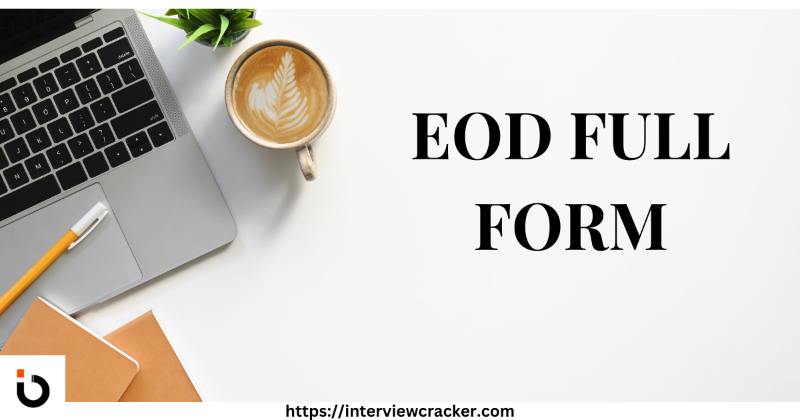EOD Full Form: Everything You Need to Know
When it comes to abbreviations, it’s easy to get lost in the jargon, especially in professional settings. One such abbreviation you might come across is “EOD.” Understanding what “EOD” stands for and its relevance can make a significant difference in your communication and planning. In this blog, we’ll explore the “EOD Full Form” and its various uses, particularly in the context of work and interviews.
What is EOD?
The “EOD Full Form” is “End of Day.” This term is commonly used in business and professional environments to denote the end of the working day. In many cases, when someone refers to “EOD,” they are setting a deadline for when a task or project should be completed. For instance, if your manager says, “Please submit the report by EOD,” they mean that the report should be submitted by the end of the current business day.
Why is EOD Important?
Understanding the “EOD Full Form” and its importance is crucial in professional settings. Knowing that “EOD” means “End of Day” helps you manage your time and deadlines more effectively. It provides a clear timeframe for when tasks should be completed and helps prioritize work accordingly. For those looking to excel in their careers or during job interviews, mastering the concept of EOD can be a valuable skill.
Using EOD in Communication
In professional communication, clarity is key. When someone specifies “EOD” in an email or a conversation, they are providing a specific deadline that is easy to understand. For example, if an email requests that a task be completed by EOD, it ensures that everyone is on the same page regarding when the task should be finished. Misunderstandings are minimized, and productivity is enhanced.
EOD in Different Contexts
The “EOD Full Form” can vary slightly depending on the context. Here are a few examples:
- Business Meetings: In business meetings, “EOD” often refers to the end of the working day when tasks or updates are expected. For example, a team leader might ask for progress reports by EOD.
- Project Management: In project management, “EOD” can be used to set deadlines for deliverables. A project manager might specify that a particular task should be completed by EOD to ensure the project stays on track.
- Emails and Communication: In emails, specifying EOD can help manage expectations and ensure timely responses. It’s a common practice to use EOD to set clear deadlines.
EOD and Job Interviews
For those preparing for job interviews, understanding the “EOD Full Form” can be particularly useful. During interviews, you might encounter questions related to time management and deadlines. Demonstrating an understanding of terms like EOD shows that you are organized and can handle time-sensitive tasks effectively.
For instance, if asked how you manage tight deadlines, you could explain how you prioritize tasks to ensure everything is completed by EOD. This shows that you are aware of professional norms and can work efficiently under pressure.
Interview Cracker Tips
To help you ace your next interview, consider these Interview Cracker tips:
- Clarify Deadlines: Always confirm deadlines if the term EOD is used. It ensures that you meet expectations accurately.
- Prioritize Tasks: Use the concept of EOD to prioritize your tasks effectively. By focusing on what needs to be done by the end of the day, you can manage your workload better.
- Showcase Your Skills: During an interview, highlight how you handle EOD tasks. Mention specific examples where you successfully met deadlines and how it contributed to your team’s success.
- Ask Questions: If you’re unsure about a deadline or task, don’t hesitate to ask for clarification. Showing that you seek clarity demonstrates a proactive attitude.
- Use Time Wisely: Manage your time efficiently by breaking down tasks and setting interim deadlines that lead up to the EOD.
Common Mistakes to Avoid
When dealing with EOD, there are some common pitfalls to avoid:
- Misinterpreting EOD: Ensure you understand whether EOD refers to the end of the working day or the end of the calendar day. This can vary based on the organization or context.
- Overpromising: Avoid committing to too many tasks with EOD deadlines if you’re unsure you can meet them. It’s better to be realistic about what can be accomplished.
- Ignoring Details: Pay attention to any additional details provided with the EOD deadline. Sometimes, specific requirements or formats are needed.
Conclusion
The “EOD Full Form” is “End of Day,” and it’s a term that plays a crucial role in professional settings. Whether you’re managing tasks, setting deadlines, or preparing for job interviews, understanding and effectively using EOD can enhance your productivity and communication. By following the Interview Cracker tips and being mindful of common mistakes, you’ll be better equipped to navigate professional environments and excel in your career. So next time you hear EOD, you’ll know exactly what it means and how to make the most of it!

